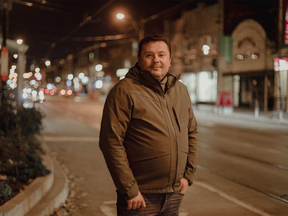Not long after Russia began bombing Ukraine, Oleksii Martynenko packed
his bags and fled Kremenchuk, a once-tranquil but now war-torn city
roughly 190 miles (300 kilometres) from Kyiv. He moved to Stockholm and
took a job as a line cook. One year later, as his work visa approached
expiry, he relocated to Canada’s largest city.
The continental change of scenery proved challenging for the Ukrainian
immigrant. It took Martynenko about two months to find a comparable job
in Toronto’s bustling downtown, about an hour’s commute from his
apartment in the city’s suburbs. It wasn’t enough to pay the bills, so
he soon took a second job, also as a line cook, and now works seven days
a week in fast-paced kitchens.
The strenuous work and high cost of living has taken its toll.
Martynenko, 44, is now planning a return to Sweden. His monthly expenses
in Toronto include roughly $100 for a phone plan , $150 for public
transit, $400 for groceries, and $1,000 for a room in a rooming house,
where the kitchen and bathroom are shared among four tenants. Any money
left over is sent back to family still in Ukraine. At least in Stockholm
he earned enough to have savings, he said.
“I’m tired all
the time now,” Martynenko said in an interview. “I want to go back to
Europe because it’s such a difficult life in Canada.”
Canada has long been a choice destination for newcomers seeking a better
life in a prosperous nation. Nearly a quarter of all Canadians are
immigrants and the country has welcomed nearly 200,000 Ukrainians since
the war’s outset. But the daily grind of life in Canada’s busiest
metropolises — not just Toronto but also Vancouver, Montreal and Calgary
— along with soaring costs is making it increasingly hard to get by.
Trudeau’s ambitious plans
Social service organizations
have warned that the country’s most vulnerable citizens — often
newcomers — are affected most by higher prices, especially in housing.
Andrei Zavialov, a settlement worker with Ukrainian Canadian Social
Services Toronto, said he knows of at least 15 Ukrainians who have
returned to their home country from the Greater Toronto Area since the
war broke out. There isn’t one predominant reason for leaving, he said,
but expenses are among the most cited factors.
“An
individual becomes unable to find money, but they need to pay for very
high rent, groceries,” said Zavialov. “And such expenses hit an
immigrant’s pocket strongly. No job, no money, they return to Ukraine
where everything is familiar.”
Anecdotal
stories like these are supported by new research suggesting that more
newcomers have chosen to leave Canada in recent years as worsening housing affordability, a strained health-care system, and underemployment spark disillusionment with the opportunities the country offers.
An
acceleration of that trend would undermine Prime Minister Justin
Trudeau’s ambitious plans to stave off economic backsliding through
relaxed immigration policies. Like many developed countries, Canada’s
birthrate is declining and the population would shrink were it not for
new arrivals. Real gross domestic product per capita has stagnated over
the past decade, while soaring home prices have far outpaced disposable
income.
The
Trudeau government’s solution is a target of roughly half a million new
permanent residents a year, on top of a recent boom in arrivals that
pushed Canada’s annual population growth rate to 2.7 per cent in 2022,
the fastest pace among advanced economies.
The challenge now is retaining them. Newcomers have to
navigate a web of problems, starting with housing costs. Even smaller
Canadian cities are facing tight rental supply
as higher interest rates have discouraged would-be buyers, creating
fierce competition for rental units. The average cost of rent in Canada
hit a record $2,149 in September, up more than 11 per cent from a year
prior, according to research firm Urbanation. In Toronto, it was $2,614,
which represents almost the entire pretax income of a person working
full-time for minimum wage.
Other costs are also rising. While inflation is decelerating,
it’s still running at 3.8 per cent, “much too high for comfort,”
according Benjamin Reitzes, a rates and macro strategist at the Bank of
Montreal. Grocery costs increased 5.8 per cent annually in September,
while gas prices jumped 7.5 per cent.
To be sure, many
newcomers are keen to stay in the country. Zavialov said most Ukrainian
newcomers he’s interacted with have expressed strong admiration for
Canada — its diverse population, socialized health-care system and
fraying but still-strong social net. The decision whether to return to
Ukraine or stay in Canada is also inspired by factors beyond expenses —
proximity to war, safety, or a sense of patriotic duty.
‘Want to help my country’
A combination of those
considerations prompted Anna-Maria Lyakhovetska to plan a return to
Ukraine as soon as it’s safe. The 17-year-old moved to Germany after her
father died in the war, and then relocated to Canada, arriving in
Toronto just seven months ago. Now she wants to go back, in part to
escape the hurdles of life in a new country and in part to aid the war
effort. Russia’s invasion, she said, encouraged her to pursue a career
in political organizing.
“It’s expensive living here,” she said. “But I also want to go back to help my country.”
The
bulk of Canada’s Ukrainian immigrant intake is clustered in Ontario,
the country’s most populous province, according social services group
Operation Ukrainian Safe Haven. Based on financial assistance data, 40
per cent of recent Ukrainian immigrants have settled in Ontario while
21.4 per cent landed in Alberta and 10.3 per cent went to Manitoba.
Oleksandr
Halyk, 50, arrived in Canada with his 25-year-old son in March,
directly from Ukraine. An engineer back home, he took a job as a cabinet
maker in north Toronto because he lacked a convertible degree. His son,
meanwhile, found a better paying job at an airport.





.jpg)


